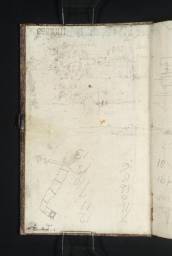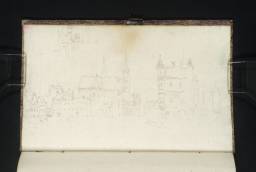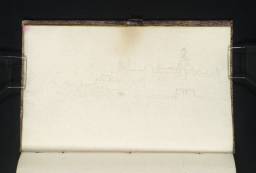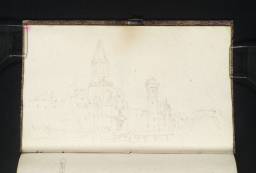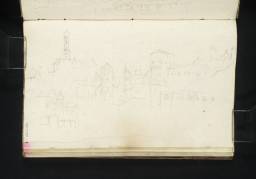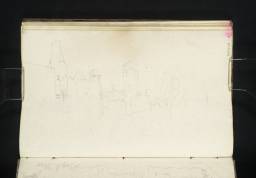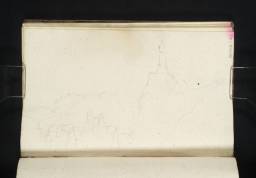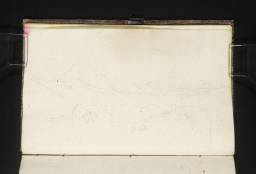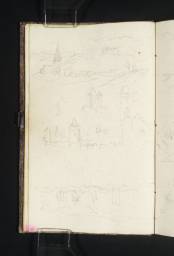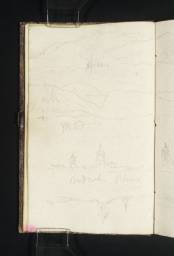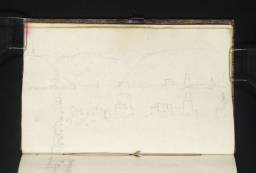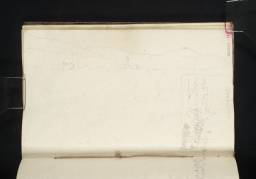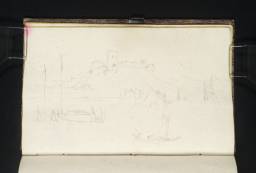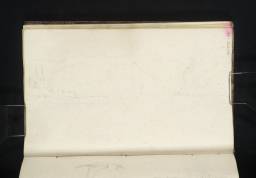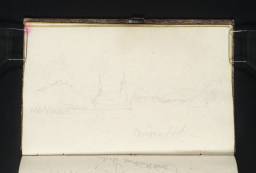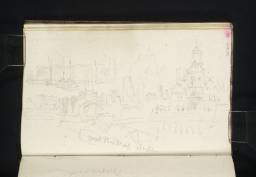Turner Bequest CCCXXII 1–64
Sketchbook bound in boards, covered in striated mauve paste-paper; leather pencil loop attached inside front cover (D32541) with traces of two more inside back cover (D32663)
62 leaves and paste-downs of white laid paper, some with unidentified rearing unicorn watermark; all edges washed with yellow; page size 170 x 105 mm
Numbered 267 as part of the Turner Schedule in 1854 and endorsed by the Executors of the Turner Bequest inside back cover (D32663)
Inscribed by Turner in ink with miscellaneous notes on paper label on front cover (D41140)
Inscribed in pencil ‘CCCXXII’ on front cover label
Stamped in black ‘CCCXXII’ on front cover, top right
62 leaves and paste-downs of white laid paper, some with unidentified rearing unicorn watermark; all edges washed with yellow; page size 170 x 105 mm
Numbered 267 as part of the Turner Schedule in 1854 and endorsed by the Executors of the Turner Bequest inside back cover (D32663)
Inscribed by Turner in ink with miscellaneous notes on paper label on front cover (D41140)
Inscribed in pencil ‘CCCXXII’ on front cover label
Stamped in black ‘CCCXXII’ on front cover, top right
Accepted by the nation as part of the Turner Bequest 1856
Exhibition history
References
This sketchbook is presented here as the last Turner used on the Continent in 1833, returning from the second of his three visits to Venice as set out in the tour’s overall Introduction. It includes subjects in southern Germany, along the River Rhine, and in and around Rotterdam, from where the artist presumably returned to England in early October. As discussed below, the book, tentatively dated to about 1837–41 in Finberg’s 1909 Inventory,1 has previously generally been associated with 1841, when Turner made the first of his four annual visits to Switzerland.
The book was not labelled by the artist beyond the pencil note ‘Holland Rhine’ inside the back cover (D32663; CCCXXII 64), a few notes of place names labelling individual drawings and an apparent mention of Rotterdam in a scrawled ink memorandum on the front cover (D41140). Finberg presumably coined its ‘Rotterdam and Rhine’ title taking these inscriptions into account, also going by John Ruskin’s customary ‘endorsement on wrapper’ (since lost), which he transcribed: ‘267. Rotterdam. Some good subjects in hard pencil.’2
This Introduction and many of the entries for individual pages are co-signed by art historian Quirine van der Meer Mohr (temporary Researcher on the Dutch material in the Turner Bequest, on placement from the University of Utrecht in 2013–14) and Matthew Imms, who is solely responsible for German entries. Each has contributed specific observations which in combination enable this sketchbook to be posited as the last link in the long itinerary of the 1833 tour. The route was otherwise convincingly established by Cecilia Powell in her 1995 Tate Gallery exhibition catalogue Turner in Germany:3 from Ostend to Cologne, east via Augsburg and Salzburg to Vienna, then west to Innsbruck and south over the Alps to Venice and back, passing through Innsbruck again and petering out at Augsburg once more, from where he ‘probably headed straight for home ... returning down the Rhine’.4 (For Finberg’s speculative unpublished notes on a route northwards from Augsburg, see the Introduction to the preceding Venice up to Trento sketchbook: Tate; Turner Bequest CCCXII).
The first key point is that the initial pages as foliated include views of Augsburg’s medieval cathedral (folio 1 verso; D32543; CCCXXII 2a) and the former abbey church of SS. Ulrich and Afra (folios 6 verso, 7 recto; D32553–D32554; CCCXXII 7a, 8), both of which are shown in the distance in other drawings of the city centre in the Venice up to Trento book (see under Tate D31655; Turner Bequest CCCXII 30); the pages between feature numerous studies of Augsburg’s old city walls. There are also scattered views in the Heidelberg up to Salzburg sketchbook, used on the outward leg (see under Tate D29930; Turner Bequest CCXCVIII 59). See under D32543 for further discussion and four further separate drawings. Apart from the 1833 route, Turner’s numerous tours within or via Germany, as set out by Powell, did not include the city.
Before coming to a second important point (with regard to dating), the longstanding association of the present book with the initial stages of Turner’s 1841 journey to Switzerland requires some exposition. Although it was not mentioned directly in Finberg’s 1939 Life of Turner, his tentative dating of it in the 1909 Inventory (along with various others5) to about 1837–41 and his calling it ‘Rotterdam and Rhine’,6 coupled with the Life’s rather fragmentary account of Turner’s route including the city in 1841,7 presumably prompted an ongoing assumption that it was used on an outward journey in the 1840s.
In his 1974 study of Turner’s Rotterdam sketches, Fred Bachrach placed the sketchbook without further comment at ‘Autumn 1841’8 along with the Rotterdam book (Tate; Turner Bequest CCCXXI), since dated by Powell to 1835.9 Andrew Wilton inferred soon afterwards that Bachrach had ‘presumably’ extrapolated from Finberg, while provisionally associating Rotterdam and by implication the present book with the 1840 tour, when Turner in fact confined himself to the Rotterdam to Venice sketchbook (Tate; Turner Bequest CCCXX) for the whole of his outward route,10 as set out elsewhere in the present catalogue.11 In her 1972 doctoral study of Turner’s work along the Rhine (published in 1978), Agnes von der Borch had also regarded the present book as likely associated with 1841,12 while acknowledging that Finberg had not mentioned it explicitly in that context.13 By 1994 Bachrach was suggesting that it and Rotterdam ‘probably belong’ to 1841 or the beginning of the Swiss tour of 1842,14 but by 2001 he had accepted that the other book was used in 1835, placing this one once more at 1841.15
By way of disentangling these shifting propositions, a terminus ante quem for this sketchbook has since been established, owing to its views of the distinctive freestanding column of the 1778 Hofpoort gateway in Rotterdam (see under folio 31 recto; D32601; Turner Bequest CCCXXII 32) which, as van der Meer Mohr has noted, was scheduled for demolition by the city council on 20 September 1833.16 Allowing for a short operational delay, Turner could presumably have seen it still in place early in October 1833, soon after his incidental notes of ‘1 Oct’ and ‘2 Oct’ on folios 58 recto and 1 recto (D32653, D32542; CCCXXII 59, 2) as he neared Rotterdam. Additionally, the Hofpoort is no longer evident near the larger Delftse Poort in the 1835 Rotterdam sketchbook (Tate D32480, D32482; Turner Bequest CCCXXI 19, 20); any later date for the present book thus becomes untenable.
A less certain terminus post quem is provided by the depiction of a steamer trailing smoke near Rotterdam, possibly representing the ‘Platluis’ ferry introduced in 1828, as discussed under folio 35 verso (D32609; CCCXXII 36a). This would preclude Turner’s 1817 tour including Holland and his journey up the Rhine and into Germany only as far as Mainz,17 when the commercial use of such vessels was in any case in its infancy,18 or that of 1825, when Cologne marked the southern-eastern limit of the German leg,19 far short of Augsburg. Since the initial pages of this sketchbook record that city, Turner presumably acquired it locally, as he had done with others throughout the tour once he had filled his only English-made book, Brussels up to Mannheim – Rhine (Tate; Turner Bequest CCXCVI).20 For the present book’s Germanic characteristics and as yet unidentified watermark, see the technical notes below.
On the basis of the preceding discussion, this book covers Turner’s homeward 1833 route from Augsburg (see under folio 1 verso; D32543; CCCXXII 2a) north-westwards to Rotterdam (see under folio 14 recto; D32468; CCCXXII 15), nearly 400 miles as the crow flies, and more like 500 by the most straightforward road and river route; few places between were paid more than passing attention. Although the general itinerary is clear from many identified subjects, particularly as he travelled back down the familiar River Rhine, he worked in somewhat randomly from both ends, rather as he had in Venice up to Trento. This renders some slighter or less distinctive landscapes, towns, castle outlines and river scenes difficult to place. Often there are multiple sketches to a page, with unidentified or generic river scenes sharing space with recognisable views, themselves sometimes from different stages.
There are no firmly identified subjects between Augsburg itself and a loose sketch apparently labelled ‘Worms’, on the Rhine between Mannheim and Mainz (folio 61 recto; D32659; CCCXXII 62). Turner had meanwhile probably largely or wholly retraced his outward steps,21 passing through or near Ulm, along the Neckar Valley via Stuttgart, Heilbronn and Heidelberg (covered particularly comprehensively in the Heidelberg up to Salzburg book: Tate; Turner Bequest CCXCVIII),22 to reach the Rhine around Mannheim. Folios 8 recto and verso (D32556–D32557; CCCXXII 9, 9a) perhaps respectively show a tower at Geislingen and a distinctive hill near Göppingen, between Ulm and Stuttgart.
After a single slight sketch apparently made at Oppenheim, on the Rhine north of Worms (folio 61 verso; D32660; CCCXXII 62a), Turner only took up the book again in earnest after Mainz. Passing west below the Rheingau district, he drew Eltville (folio 60 verso; D32658; CCCXXII 61a) and Schloss Johannisberg (see under folio 60 recto; D32657; CCCXXII 61), before approaching Rüdesheim (see under folio 11 verso; D32563; CCCXXII 12a) and Bingen, showing various aspects of Burg Klopp, the Mäuseturm and Burg Ehrenfels (see under folio 12 verso; D32565; CCCXXII 13a).
After Bingen the river turns north-west, and Turner entered the picturesque reaches of the Middle Rhine once more. He had already made a great many drawings of the castles and other riverside scenes upstream of Cologne in the Brussels up to Mannheim – Rhine book a few weeks before, and his coverage was now more sporadic. There are sketches of Burg Sooneck (folio 57 verso; D32652; CCCXXII 58a) and possibly Bacharach (folio 57 recto; D32651; CCCXXII 58), and a cluster around Kaub (see under folio 55 recto; D32647; CCCXXII 56), Oberwesel (see under folio 54 verso; D32646; CCCXXII 55a) and their castles. Then there is a hiatus before views of the Marksburg (or Marxburg; see under folio 18 verso; D32577; CCCXXII 19a), Schloss Stolzenfels (see under folio 19 recto; D32578; CCCXXII 20) and nearby Burg Lahneck (folio 38 recto; D32614; CCCXXII 39), overlooking the mouth of the River Lahn.
Soon afterwards, the artist reached Coblenz (Koblenz) and the mouth of the Mosel (folio 22 verso; D32585; CCCXXII 23a), but as ever his attention was more taken by the looming Ehrenbreitstein fortress opposite, high above the east bank of the Rhine, of which he made several studies (see under folio 25 recto; D32590; CCCXXII 26). About thirty miles further on, he studied the shifting juxtapositions of Burg Rolandseck, Nonnenwerth and Burg Drachenfels; the latter, on its craggy summit, particularly engaged him this time (see under folio 16 verso; D32573; CCCXXII 17a).
A few miles downstream, after Bonn, Turner entered the Lower Rhine, possibly pausing at Cologne only to make an unusually heavily worked sketch looking over the bridge of boats to the abbey at Deutz (folio 37 recto; D32612; CCCXXII 38), recording a stormy or twilight effect. Neuss and its basilica (folio 30 recto; D32599; CCCXXII 31) came next, with nearby Düsseldorf (folios 25 verso, 26 recto; D32591–D32592; CCCXXII 26a, 27), then apparently one of the two Büderichs (folios 10 verso–11 recto; D32561–D32562; CCCXXII 11a–12) between there and Wesel (folio 49 verso; D32637; CCCXXII 50a), either side of Uerdingen, near Krefeld (folio 37 verso; D32613; CCCXXII 38a).
Downstream of Wesel are the last identified German subjects, Rees and Emmerich (folios 29 verso, 21 verso; D32598, D32583; CCCXXII 30a, 22a), and Turner now continued his river odyssey into the Netherlands. Where the Rhine divides into the Waal and the narrower Nederrijn, he took the latter north-west to Arnhem (see inside the front cover; D32541; CCCXXII 1), then bearing west, past the soaring church tower at Rhenen (folio 49 recto; D32636; CCCXXII 50) and the small castle at Wijk bij Duurstede (folio 48 verso; D32635; CCCXXII 49a). There, the main branch of the river becomes the Lek, along which he next drew Schoonhoven (see under folios 22 recto, 23 recto; D32584, D32586; CCCXXII 23, 24); the Lek in turn ends at the confluence with the Noord, east of Rotterdam, forming the Nieuwe Maas (New Meuse) on which the city stands. Perhaps just before reaching it, he sketched boats on the Hollandse Ijssel River (folios 47 verso–48 recto; D32633–D32634; CCCXXII 48a–49) and at IJsselmonde (folio 57 verso; D32652; CCCXXII 58a).
As noted above, the sketches in and around the city are listed under folio 14 recto (D32468; CCCXXII 15), and constitute the most intensive albeit scattered grouping in this book, with subjects on over thirty pages. Otherwise only Augsburg, covered more systematically in the dozen pages at the beginning which complement numerous other drawings from this tour, received such sustained attention. Nearly thirty more pages comprise or include as yet unrecognised scenes, most being rapid passing sketches along the rivers. Given Turner’s unsystematic working sequence, they do not necessarily relate to adjacent known subjects views. A few of the more distinctive (such as folios 23 recto, 36 verso and 51 verso; D32586, D32611, D32641; CCCXXII 24, 37a, 52a) may yet prove identifiable.
Naturally, many drawings include boats of various types, some particularly prominently or as separate studies (folios 12 verso, 15 verso–16 recto, 32 recto, 36 recto, 47 verso–48 recto, 48 verso, 50 recto, 57 recto; D32565, D32571–D32572, D32603, D32610, D32633–D32634, D32635, D32638, D32651; CCCXXII 13a, 16a–17, 33, 37, 48a–49, 49a, 51, 58). Three feature steamers (folios 35 verso, 53 recto, 61 recto; D32609, D32643, D32659; CCCXXII 36a, 54, 62). Finally, folio 62 recto (D32661; CCCXXII 63) is a scene with numerous figures, possibly taken from a painting, and there are what seem to be two related studies of a young man in an old-fashioned outfit, who may be a student (24 verso, 26 recto; D32589, D32592; CCCXX II 25a, 27).
Turner had been in the Austrian Alps at Innsbruck on 23 September, after leaving Venice a few days before (see the tour’s Introduction), and from there it was not far to Augsburg; he was in the Arnhem area by 2 October (see folio 1 recto; D32542; CCCXXII 2). As discussed in relation to notes on the front cover (D41140), he was back on important business in London by 15 October, presumably having sailed direct from Rotterdam, possibly having lingered there not more than a day or two. This book was thus in use for a relatively brief period, and none of the sketches became direct sources for subsequent watercolours or paintings.
See Cecilia Powell, Turner in Germany, exhibition catalogue, Tate Gallery, London 1995, pp.35–45, 112–15, 221–30; the present sketchbook is not mentioned in relation to the 1833 tour or otherwise.
Powell 1995, p.44; see also Cecilia Powell, ‘Approaches to Venice’ in Ian Warrell, David Laven, Jan Morris and others, Turner and Venice, exhibition catalogue, Tate Britain, London 2003, p.32.
See Finberg 1909, II, pp.956–1047 for numerous Continental sketchbooks dated c.1837–40, c.1840 or c.1837–41.
See Alexander J. Finberg, The Life of J.M.W. Turner, R.A. Second Edition, Revised, with a Supplement, by Hilda F. Finberg, revised ed., Oxford 1961, p.392 for Rotterdam, and p.384, where ‘Holland’ is mentioned along with particular Swiss subjects. The late Swiss tours of 1841–4 remain to be addressed in the present catalogue at time of writing: for more recent brief accounts of the 1841 trip, see Ian Warrell, Through Switzerland with Turner: Ruskin’s First Selection from the Turner Bequest, exhibition catalogue, Tate Gallery, London 1995, p.11, and Wilton 2006, p.242.
Bachrach 1974, p.[79]; followed without further comment in van Beveren and van Sinderen 2001, p.11, and Seibold-Bultmann 2003, p.15.
See also chronologies in Wilton 1987, p.208 and 2006, p.242, maintaining that this sketchbook and Rotterdam were ‘probably’ both used in 1840.
See Quirine van der Meer Mohr, ‘Dating J.M.W. Turner: Another Visit to the Netherlands’, Tate Research Feature, February 2014, accessed 2 September 2019, https://www.tate.org.uk/research/features/dating-turner ; the date of the decision is mentioned in the integral caption to a postcard from an 1826 watercolour of the gateway by a local artist, D. Moens, imaged as ‘Hofpoort met Zwanengat en Blauwebrug. Rotterdam’, Stadtsarchief Rotterdam, accessed 2 September 2019, http://collecties.stadsarchief.rotterdam.nl/publiek/detail.aspx?xmldescid=398540 . The original is in the same collection: ‘Pompenburgsingel. Blauwe Molen en Hofpoort, Galerij’, http://collecties.stadsarchief.rotterdam.nl/publiek/detail.aspx?xmldescid=874498 .
Technical notes
How to cite
Matthew Imms and Quirine van der Meer Mohr, ‘Rotterdam and Rhine Sketchbook 1833’, sketchbook, November 2019, in David Blayney Brown (ed.), J.M.W. Turner: Sketchbooks, Drawings and Watercolours, Tate Research Publication, March 2023, https://www


